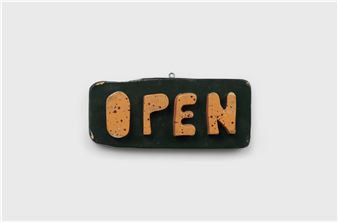Atomic Surplus
Atomic Surplus is a multi-faceted project that examines what it means to live in the birthplace of the atomic bomb. Through art that addresses not only New Mexico identity, but also the larger realms of science, environment, war, activism, fear and hope, Atomic Surplus will consist of a major group exhibition; a sub-exhibition of historic artworks; a film series; a lecture series; hands-on, field-based children's education program; essay-driven exhibition catalog; and online archive.
Through a multi-pronged approach and working with diverse partners, Atomic Surplus illustrates a diversity of perspectives on the nuclear legacy. The project not only references historical moments and regional connections, but uses New Mexico and the WWII-era as a touchstone for looking at much more global and contemporary consequences.
As centerpiece of the Atomic Surplus project, this group exhibition sets the tone for its auxiliary programs and publications. The work of 12 international artists represents a variety of topics and viewpoints. Presented in various media, the artworks depict everything from the first atomic bomb tests to nuclear waste facilities to the thriving wildlife in Chernobyl to the meltdown in Fukushima to the promise of nuclear power. Atomic Surplus does not take a position on the nuclear issue, but exposes audiences to a range of imagery and ideas. A color catalog accompanies the exhibition, with short essays from artists, scholars, historians, and others.
Artists Include:
Center for Land Use Interpretation (Los Angeles), ChimÎPom (Tokyo), Peter Cusack (London), Nina Elder (Santa Fe), Eric Lusito (France), Rankin & Dub Ainu Band (Tokyo), Vanessa Renwick (Portland, Oregon), Bettina Samson (Paris), Jim Sanborn (Washington, DC), Claudia X. Valdes (Albuquerque), Greta Young (Santa Fe), Luca Zanier (Switzerland)

Recommended for you
Atomic Surplus is a multi-faceted project that examines what it means to live in the birthplace of the atomic bomb. Through art that addresses not only New Mexico identity, but also the larger realms of science, environment, war, activism, fear and hope, Atomic Surplus will consist of a major group exhibition; a sub-exhibition of historic artworks; a film series; a lecture series; hands-on, field-based children's education program; essay-driven exhibition catalog; and online archive.
Through a multi-pronged approach and working with diverse partners, Atomic Surplus illustrates a diversity of perspectives on the nuclear legacy. The project not only references historical moments and regional connections, but uses New Mexico and the WWII-era as a touchstone for looking at much more global and contemporary consequences.
As centerpiece of the Atomic Surplus project, this group exhibition sets the tone for its auxiliary programs and publications. The work of 12 international artists represents a variety of topics and viewpoints. Presented in various media, the artworks depict everything from the first atomic bomb tests to nuclear waste facilities to the thriving wildlife in Chernobyl to the meltdown in Fukushima to the promise of nuclear power. Atomic Surplus does not take a position on the nuclear issue, but exposes audiences to a range of imagery and ideas. A color catalog accompanies the exhibition, with short essays from artists, scholars, historians, and others.
Artists Include:
Center for Land Use Interpretation (Los Angeles), ChimÎPom (Tokyo), Peter Cusack (London), Nina Elder (Santa Fe), Eric Lusito (France), Rankin & Dub Ainu Band (Tokyo), Vanessa Renwick (Portland, Oregon), Bettina Samson (Paris), Jim Sanborn (Washington, DC), Claudia X. Valdes (Albuquerque), Greta Young (Santa Fe), Luca Zanier (Switzerland)













